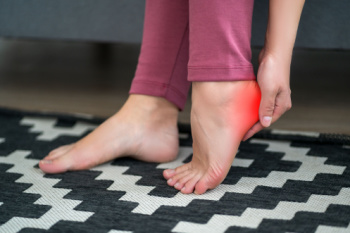March 2024
Plantar Warts Can Be Treated!
Conditions Associated With Heel Spurs
 Heel spurs are bony growths that develop on the underside of the heel bone, often near the point where the plantar fascia connects to the bone. While they can be asymptomatic, heel spurs are frequently associated with certain foot conditions, serving as indicators of underlying issues. Primarily, they're linked with plantar fasciitis, a condition where the ligament running along the bottom of your foot becomes inflamed and causes heel pain. This inflammation can lead to the development of a spur. Heel spurs are also frequently associated with chronic conditions stemming from strain on the foot muscles and ligaments, or from repeated tearing of the membrane that covers the heel bone. Such strain and tearing can be due to excessive weight, poor shoe choices, or an active lifestyle without adequate foot support. The association of heel spurs with other conditions typically means there will be a comprehensive approach to treatment, which may include stretches, orthotic support, or lifestyle modifications to address the root cause of the pain. If you are suffering from a heel spur, it is suggested you make an appointment with a podiatrist who can diagnose the underlying problem and help you find relief.
Heel spurs are bony growths that develop on the underside of the heel bone, often near the point where the plantar fascia connects to the bone. While they can be asymptomatic, heel spurs are frequently associated with certain foot conditions, serving as indicators of underlying issues. Primarily, they're linked with plantar fasciitis, a condition where the ligament running along the bottom of your foot becomes inflamed and causes heel pain. This inflammation can lead to the development of a spur. Heel spurs are also frequently associated with chronic conditions stemming from strain on the foot muscles and ligaments, or from repeated tearing of the membrane that covers the heel bone. Such strain and tearing can be due to excessive weight, poor shoe choices, or an active lifestyle without adequate foot support. The association of heel spurs with other conditions typically means there will be a comprehensive approach to treatment, which may include stretches, orthotic support, or lifestyle modifications to address the root cause of the pain. If you are suffering from a heel spur, it is suggested you make an appointment with a podiatrist who can diagnose the underlying problem and help you find relief.
Heel spurs can be incredibly painful and sometimes may make you unable to participate in physical activities. To get medical care for your heel spurs, contact Dr. Lee R. Stein from Lake Shore Foot & Ankle, PC. Our doctor will do everything possible to treat your condition.
Heels Spurs
Heel spurs are formed by calcium deposits on the back of the foot where the heel is. This can also be caused by small fragments of bone breaking off one section of the foot, attaching onto the back of the foot. Heel spurs can also be bone growth on the back of the foot and may grow in the direction of the arch of the foot.
Older individuals usually suffer from heel spurs and pain sometimes intensifies with age. One of the main condition's spurs are related to is plantar fasciitis.
Pain
The pain associated with spurs is often because of weight placed on the feet. When someone is walking, their entire weight is concentrated on the feet. Bone spurs then have the tendency to affect other bones and tissues around the foot. As the pain continues, the feet will become tender and sensitive over time.
Treatments
There are many ways to treat heel spurs. If one is suffering from heel spurs in conjunction with pain, there are several methods for healing. Medication, surgery, and herbal care are some options.
If you have any questions feel free to contact one of our offices located in Chicago, Highland Park, and Uptown, IL . We offer the latest in diagnostic and treatment technology to meet your needs.
Finding Athletic Shoes for Your Feet

In the dynamic world of athletic footwear, finding the perfect fit is paramount for optimal performance and foot health. Whether you are an athlete or a casual exerciser, understanding your foot type and specific needs will guide your selection process. Flat feet, overpronation, plantar fasciitis, and arthritis are just a few factors that can influence your shoe selection process. Seek out shoes with features tailored to your sports or exercise needs. Remember to prioritize fit. This can be done by shopping towards the end of the day when your feet are slightly swollen and making sure of the correct size. Differentiate between motion control, stability, and cushioned shoes to find the style that best suits your requirements, whether you need maximum support or prefer a more flexible option. It is suggested that you schedule an appointment with a podiatrist for a gait analysis and examination of your feet to help in determining the particular needs you may have to help in choosing the right athletic shoes for you.
You should always make sure your running shoes fit properly in order to avoid injury. For more information, contact Dr. Lee R. Stein from Lake Shore Foot & Ankle, PC. Our doctor can provide the care you need to keep you pain-free and on your feet.
Choosing the Right Running Shoe for Your Foot Type
Improper shoe sizing can cause a myriad of problems for your feet. Shoes that don’t fit you properly can lead to muscular imbalances in your body, which can result in foot, knee, and hip injuries.
Tips for Finding the Right Running Shoe
- Make sure you have a thumb’s width of wiggle room between the end of your longest toe and the front of the shoe.
- There should be little to no slipping at the heel
- Don’t assume your size in one shoe brand will be your size in another
- Do not lace up your shoes too tightly
- Walk around in the store with your new shoes before you buy them
If you have any questions please feel free to contact our one of our offices located in Chicago, Highland Park, and Uptown, IL . We offer the newest diagnostic and treatment technologies for all your foot and ankle needs.
Preventing Diabetic Foot Ulcers

Diabetes requires ongoing medical care beyond controlling blood sugar. Foot ulcers, a common complication, pose serious health risks. 19% to 34% of people with diabetes are likely to develop a foot ulcer at least once in their lifetime. There is a 2% yearly incidence of diabetic patients developing foot ulcers, with high recurrence rates after healing. Poor foot care raises the risk of a diabetic patient developing ulcers, infections, and amputations. Studies show varied foot care practices globally can contribute to injury risk. These include infrequent foot and shoe checks, inadequate foot hygiene, and walking barefoot. To reduce diabetic foot complications, patients need education on proper foot care, regular check-ups, and to avoid risky behaviors, like walking barefoot or wearing improper footwear. If you are a diabetic, it is strongly suggested that you make regular visits with a podiatrist for routine examinations and care.
Diabetic foot care is important in preventing foot ailments such as ulcers. If you are suffering from diabetes or have any other concerns about your feet, contact Dr. Lee R. Stein from Lake Shore Foot & Ankle, PC. Our doctor can provide the care you need to keep you pain-free and on your feet.
Diabetic Foot Care
Diabetes affects millions of people every year. The condition can damage blood vessels in many parts of the body, especially the feet. Because of this, taking care of your feet is essential if you have diabetes, and having a podiatrist help monitor your foot health is highly recommended.
The Importance of Caring for Your Feet
- Routinely inspect your feet for bruises or sores.
- Wear socks that fit your feet comfortably.
- Wear comfortable shoes that provide adequate support.
Patients with diabetes should have their doctor monitor their blood levels, as blood sugar levels play such a huge role in diabetic care. Monitoring these levels on a regular basis is highly advised.
It is always best to inform your healthcare professional of any concerns you may have regarding your feet, especially for diabetic patients. Early treatment and routine foot examinations are keys to maintaining proper health, especially because severe complications can arise if proper treatment is not applied.
If you have any questions please feel free to contact one of our offices located in Chicago, Highland Park, and Uptown, IL . We offer the newest diagnostic and treatment technologies for all your foot and ankle needs.
Surgery for Plantar Fasciitis

Plantar fasciitis is characterized by inflammation of the plantar fascia in the feet, leading to extreme pain and limiting daily activities. When conservative treatments fail to provide adequate relief, surgical intervention may become an option. Surgery for plantar fasciitis involves partial release of the plantar fascia from tension and may include removal of heel bone spurs. This procedure is often performed under local anesthesia, with same-day discharge. Post-surgery, patients will undergo a strict recovery regimen. Refraining from strenuous activities for the first month and using supportive footwear and aids such as air casts and crutches may be prescribed by a podiatrist. Regularly changing the dressing is vital to prevent infection. A gradual return to activities may begin after a month, and certain exercises can help to restore foot movements and muscle strength. While tissues may heal within weeks, full recovery from plantar fasciitis surgery typically takes several months. To find out whether surgery for plantar fasciitis is an option for you, it is suggested that you schedule an appointment with a podiatrist to assess treatment choices.
Foot surgery is sometimes necessary to treat a foot ailment. To learn more, contact Dr. Lee R. Stein of Lake Shore Foot & Ankle, PC. Our doctor will assist you with all of your foot and ankle needs.
When Is Surgery Necessary?
Foot and ankle surgery is generally reserved for cases in which less invasive, conservative procedures have failed to alleviate the problem. Some of the cases in which surgery may be necessary include:
- Removing foot deformities like bunions and bone spurs
- Severe arthritis that has caused bone issues
- Cosmetic reconstruction
What Types of Surgery Are There?
The type of surgery you receive will depend on the nature of the problem you have. Some of the possible surgeries include:
- Bunionectomy for painful bunions
- Surgical fusion for realignment of bones
- Neuropathy decompression surgery to treat nerve damage
Benefits of Surgery
Although surgery is usually a last resort, it can provide more complete pain relief compared to non-surgical methods and may allow you to finally resume full activity.
Surgical techniques have also become increasingly sophisticated. Techniques like endoscopic surgery allow for smaller incisions and faster recovery times.
If you have any questions please feel free to contact one of our offices located in Chicago, Highland Park, and Uptown, IL . We offer the newest diagnostic and treatment technologies for all your foot and ankle needs.
Arthritis Can Cause Pain in the Feet and Ankles
Blog Archives
- March 2025
- February 2025
- January 2025
- December 2024
- November 2024
- October 2024
- September 2024
- August 2024
- July 2024
- June 2024
- May 2024
- April 2024
- March 2024
- February 2024
- January 2024
- December 2023
- November 2023
- October 2023
- September 2023
- August 2023
- July 2023
- June 2023
- May 2023
- April 2023
- March 2023
- February 2023
- January 2023
- December 2022
- November 2022
- October 2022
- September 2022
- August 2022
- July 2022
- June 2022
- May 2022
- April 2022
- March 2022
- February 2022
- January 2022
- December 2021
- November 2021
- October 2021
- September 2021
- August 2021
- July 2021
- June 2021
- May 2021
- April 2021
- March 2021
- February 2021
- January 2021
- December 2020
- November 2020
- October 2020
- September 2020
- August 2020
- July 2020
- June 2020
- May 2020
- April 2020
- March 2020
- February 2020
- January 2020
- December 2019
- November 2019
- October 2019
- September 2019
- August 2019
- July 2019
- June 2019
- May 2019
- April 2019
- March 2019
- February 2019
- January 2019
- December 2018
- November 2018
- October 2018
- September 2018
- August 2018
- July 2018








